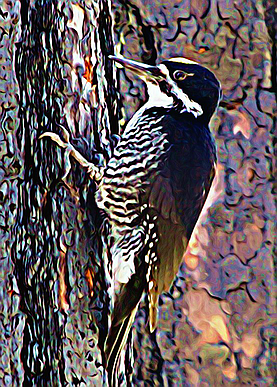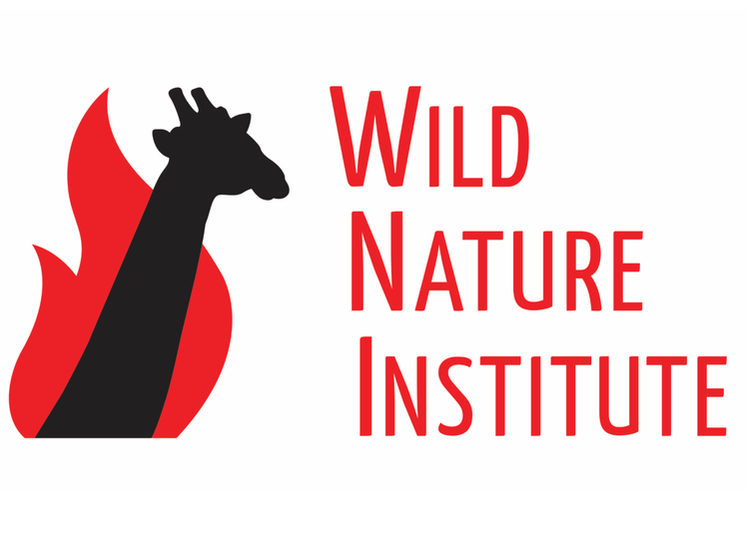Dead Trees are Vital
Dead trees can remain standing for decades or more and a standing dead tree—known as a "snag"—provides great habitat for wildlife. Birds and mammals make their homes in openings carved within snags, while wood-boring insects that feed on snags provide the foundation of the food chain for a larger web of forest life, akin to plankton in the ocean. With so much life abounding, it doesn't seem right to call a snag "dead." We commonly associate that word with meaning the end of one's useful life and yet when a tree becomes a snag, it actually reaches a pinnacle of its beneficial role in the ecosystem. In other words, snags are a vital and vibrant part of the forest. When many snags are created together in what is known as a "snag forest," it produces some of the highest levels of native biodiversity of any forest type. Some forest animals, such as black-backed woodpeckers, depend on finding places with large swaths of snags. Unfortunately for them, unlogged snag forests have become quite rare. The Deficit of Dead Trees From the perspective of the timber industry, a snag in the forest is a waste, so timber companies and the Forest Service have spent decades cutting down snags as quickly as possible. As a result, there is now a significant lack of snags in our forests and this shortage is harming woodpeckers, owls and other forest wildlife. For them, the recent pulse of snag creation is good news. At first glance, 66 million dead trees may seem like a very large number, but it is important to remember that there are 33 million acres of forest in California, so the total effect of the recent pulse of tree mortality has been to add an average of only two snags per acre. To put that number in perspective, forest animals that live in snags generally need at least four to eight snags per acre to provide sufficient habitat and some species require even more snags. For example, California spotted owls use forests with eight to twelve snags to nest and rest and they prefer even higher levels of snags in the areas where they gather their food. And black-backed woodpeckers depend on snag forests with at least several dozen dead trees per acre. These points and many others were addressed in a letter from scientists to California Gov. Brown in February. Cashing in on Fear of Fire Despite the ecological benefits from the recent pulse of tree mortality, logging advocates have been eager to cut down the snags. In attempting to sway the public to support large-scale logging, they have not highlighted the wildlife habitat created by these snags or the overall snag deficit, but instead they have stoked fears that dead trees will cause severe wildfires. This claim is generally presented by portraying the trees only as "fuel" for fire. Depicting trees solely as "fuel" is a simplistic and misleading approach that reduces the natural complexity of the forest to a single dimension, resulting in erroneous assumptions about what really occurs. In fact, dozens of published scientific studies of what actually happens when beetle-affected areas burn show that dead trees do not cause severe fires. One recent study even found that areas with tree mortality burn at lower severity than green tree forests. Dr. Dominick DellaSala of the Geos Institute recently published a synthesis of this research and concluded, "There is now substantial field-based evidence showing that beetle outbreaks do not contribute to severe fires nor do outbreak areas burn more severely when a fire does occur." The results of the field research are inconvenient for those who try to use tree mortality as a justification for more logging. For example, U.S. Secretary of Agriculture Tom Vilsack, who oversees the Forest Service, made no mention of these studies in his June press release about the California tree mortality. Instead, he falsely claimed that the tree die-offs "increase the risk of catastrophic wildfires" and then he used that claim to lobby for increased funding for his agency. The biomass power industry in California is also trying to cash in on this fire scare regarding dead trees. Biomass power facilities generate electricity by burning trees and other vegetation. This process is remarkably inefficient, with biomass burning facilities contributing to global warming by emitting more carbon per unit of energy produced than coal or natural gas facilities. (Moreover, in contrast to biomass power, renewable energy sources that don't burn carbon—such as roof-top solar—have no emissions). Biomass power is also economically inefficient, requiring substantial taxpayer and ratepayer subsidies, as well as regulatory loopholes, to keep biomass facilities in business. Thus, the current use of fear of fire to try to justify subsidized logging of snags to fuel biomass facilities is bad news for the climate and taxpayers, as well as for forest ecosystems. A New Understanding of Forest Diversity Rather than allowing logging proponents to exploit fear and misinformation about fire, we have a collective opportunity to learn from the current pulse of tree mortality and develop a greater understanding of the full diversity of California's forests. Dead trees, including large patches of snags, are a vital part of the forest. We should appreciate them, along with the natural processes that create them, such as beetles and wildfires. While forest protection efforts have historically focused on green trees, forests come in a variety of colors that also deserve protection, including trees with brown needles and trees with blackened bark. Their diversity provides the basis for a diversity of forest life. reprinted from EcoWatch Aug 06, 2016 By Douglas Bevington Douglas Bevington is the forest program director for Environment Now and the author of The Rebirth of Environmentalism: Grassroots Activism from the Spotted Owl to the Polar Bear (Island Press, 2009). Original article available at: http://www.ecowatch.com/dont-get-burned-by-misinformation-about-dead-trees-and-wildfire-1957452382.html
3 Comments
Randy Piper
8/27/2016 12:00:52 pm
As someone whom grew up on a small family farm, has been an environmentalist since long before it became popular, and has spent almost 12 years and thousands of hours devouring information to better understand the environmental, social, and economic issues and impacts resulting from the unprecedented 20 years of the pine beetle epidemic that has resulted in a 60-90% tree mortality rate spanning approximately 160 million acres in Western North America, I would really love to hear both Mr. Bevington's and the Wild Nature Institute's views on the BIG picture - one that encompasses not only the environmental aspects, but also the social and economic impacts - in an effort to find the middle ground in our societies responsible course of action as billions more trees die in the beetles march across the Boreal Forest of Canada, back into the North Cental USA, and onward to the East Coast as predicted over the next 20+ years.
Reply
Dr. Derek E. Lee
8/28/2016 01:38:52 am
Thanks for your comments Randy. Your concern about the forest is important, and I hope you are spreading the word about the natural nature of beetles and fire. The big picture is simple, climate change is contributing to forest insect outbreaks, however, the current outbreak is not unprecedented. The current climate warming is largely human-created, but the Earth's climate has been this warm and warmer before, so species in forest ecosystems carry the evolutionary intelligence within their genes to withstand the current changes, and all organisms are constantly evolving. Deer, elk and bear especially love beetle-killed and severely burned forest to take advantage of the superabundance of forage available there. There is no happy medium, the forest should be left alone to adapt to the changing conditions. When humans interfere, they only disturb the evolution of the forest. The individual trees that survive a fire or outbreak are specially adapted and carry important genetic information that is destroyed when we clearcut and replant. The economic and societal value of the water supply ecological services provided by our forests vastly outweigh all other considerations of 'resource use' and fire and insects don't harm this service, but logging does extensive and irreparable damage to the water supply services of our forests. We do not need to utilize those dead trees outside their site, in fact they are critical source of nutrients and water storage in place, and no other use could come close to equalling the value of those services. I hope that gives you an adequate big picture perspective, and I welcome any additional questions you may have.
Reply
Your comment will be posted after it is approved.
Leave a Reply. |
Science News and Updates From the Field from Wild Nature Institute.
All Photos on This Blog are Available as Frame-worthy Prints to Thank Our Generous Donors.
Email Us for Details of this Offer. Archives
July 2024
|
|
Mailing Address:
Wild Nature Institute PO Box 44 Weaverville, NC 28787 Phone: +1 415 763 0348 Email: [email protected] |
|


 RSS Feed
RSS Feed
